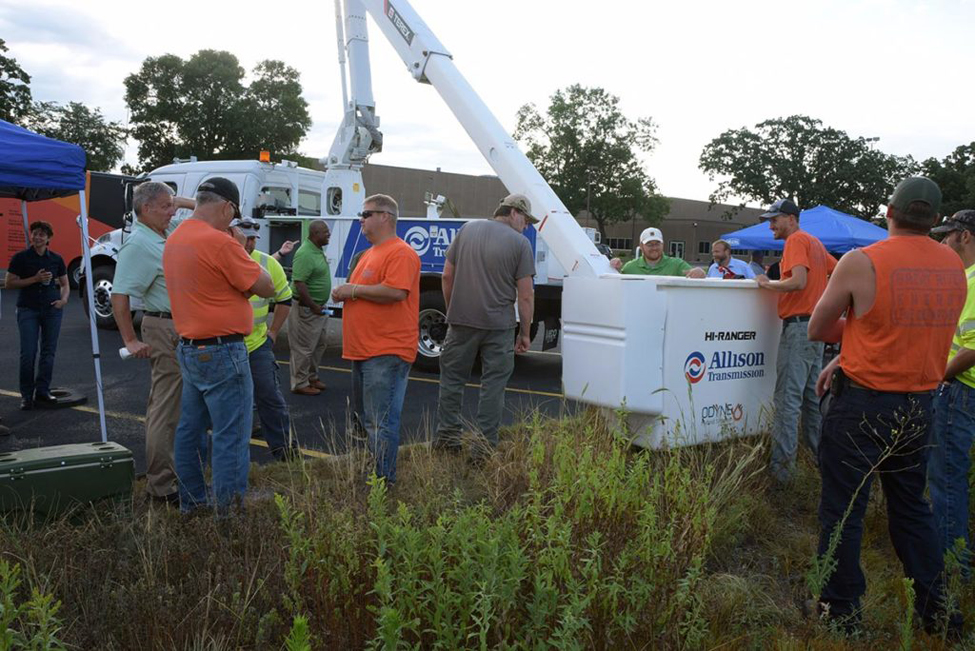Minnesota co-op “spreads the word” about hybrid electric bucket trucks
Courtesy: Erin Kelly, National Rural Electric Cooperative Association (NRECA)
The iconic bucket truck is increasingly going electric.
Maple Grove, Minnesota-based Great River Energy (GRE) recently held a Utility Fleet Electric Vehicle Demonstration Day that featured a plug-in hybrid electric bucket truck. A diesel truck was equipped with a bucket and aerial lift apparatus that runs on an electric motor and batteries manufactured by Odyne Systems in Wisconsin.

When lineworkers reach a job site, they can turn off the truck’s diesel motor, push a button and switch to all-electric mode to power the bucket arm and provide export power for tools, eliminating the need for the truck to idle, and reducing noise and pollution. The electric mode can even power the air conditioning or heating in the truck’s cab while lineworkers eat lunch.
Great River Energy, a generation and transmission cooperative, invited all 28 of its member co-ops to get an up-close look at the hybrid bucket truck, and about 100 people showed up, Aug. 2, to the daylong demonstration. One co-op, East Central Energy, in Braham, Minnesota, already has a hybrid truck on order and Great River Energy is researching the possibility, said Rodney DeFouw, GRE’s member electrification strategist.
“There’s been a lot of positive conversation that came out of this event,” DeFouw said. “A lot of people didn’t realize that these trucks existed.”
Leonard Lincoln, director of sales at Odyne Systems, said the company has been making hybrid bucket trucks for more than a decade, but has seen an uptick in interest from co-ops and other
utilities in recent years. Odyne, which also installs the system in garbage trucks, street sweepers and other vehicles, has sold more than 200 hybrid bucket trucks, Lincoln said.
“A lot of it has to do with climate change and incentives to reduce greenhouse gas emissions and utilities trying to do the right thing.” Lincoln said.
He said the system cuts costly diesel consumption by two-thirds, reduces
greenhouse gas emissions by 65%, and slashes smog-creating nitrogen oxide emissions by more than 90%. It also lowers decibel levels by as much as 50%, making it easier for co-op crews to communicate.
Basically, the process works like this: A co-op would bring a manufacturer of the hybrid electric system together with the manufacturer or dealer for whatever type of truck it wants to buy. The chassis is built first, then the electric system is installed, then the truck goes to final stage manufacturing to add the bucket apparatus.
If a co-op chose a traditional diesel truck, it would be fitted with one or more batteries and an electric motor attached to the transmission that inverts DC power into AC power, Lincoln said. If a co-op buys an electric truck, there would be no transmission, and everything would work off of the electric motor.
The price varies for hybrid bucket trucks, but they can cost tens of thousands of dollars more than conventional trucks, DeFouw said. It would take a co-op six to seven years to get a full return on investment from fuel savings and lower maintenance costs, Lincoln said. Utilities would likely keep the trucks 12 to 15 years.
After GRE’s demonstration day, three of its member co-ops borrowed the hybrid bucket truck to try it out, DeFouw said.
“This is just the start,” DeFouw said. “We’re spreading the word. We want to get good info out there to our members and expose them to things that will benefit their businesses and their lives.”
Steele-Waseca Cooperative Electric Operations Division Manager Dan Meier, who was unable to attend the demonstration, stated, “I do know that there is some interest in the hybrid solution, but I think it is still in the infancy stages. This is something that might be looked at in the near future.”

Innovation
#swceINNOVATION





